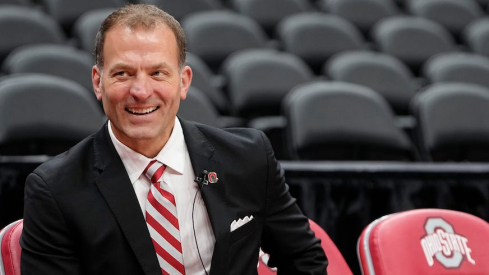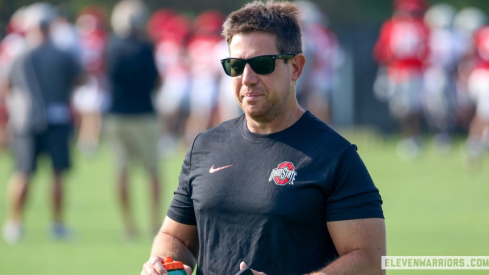"West Virginia is a veteran team. They have an experienced quarterback, two great receivers, one of the best running backs in college football, and an offensive line with four returning starters and they all average 300 pounds at least. They are a big and experienced football team." - John Cooper
Few openers have been as anticipated as the Buckeyes' trip to Morgantown in 1998. The defending Rose Bowl champions were ranked #1 in the nation and hoped to claim the first B.C.S. title in college football history.
Standing in their way, however, was a veteran West Virginia offense led by a Heisman candidate at running back. But as many football fans now recognize, there was plenty of talent on that Mountaineer offense, with Pro Bowl quarterback Marc Bulger and tight end Anthony Becht lining up beside "Famous" Amos Zereoue.
| #1 |
 |
Ohio State | 34 |
| #11 |
 |
West Virginia | 17 |
Despite breaking the huddle with a veteran running back and offensive line, however, the Mountaineers didn't attempt to push a young Buckeye defensive front around. Rather, when the home team lined up after receiving the opening kickoff, they did so in a single back set with three receivers split out wide; a novelty in the 1990s.
After Zereoue took a pitch around the edge for a big gain on first down, the Mountaineers stayed in the look, forcing the talented trio of Buckeye linebackers to spread out and cover ground from sideline-to-sideline. As they came to the line a second time, WVU sent a wideout in motion to create a 3x1 look to the field and ran what would later become known as a Run-Pass Option (RPO).
After taking the snap, Bulger quickly threw out wide on a screen pass to the motioning wideout while the line blocked an outside zone run for Zereoue. Today, we'd simply think of this as a Bubble Screen relief to open up the run, but in 1998 it was something out of science fiction on the football field.
The Mountaineers spent the majority of the first half in three and four-receiver sets, rarely using a fullback and looking to get Zereoue on the edges by using the same blocking scheme made popular at the time by the Super Bowl-winning Broncos. But while Butkus-winning middle linebacker Andy Katzenmoyer looked to mirror the talented back inside, SAM linebacker Jerry Rudzinski (#35) was forced to chase down bubble screens outside, something rarely asked of players like him at the time.
Thanks to All-Everything cornerback Antoine Winfield, however, gains on such plays were held to a minimum, forcing the Mountaineers to work for every yard in the first half. The eventual Thorpe winner that season was everywhere on opening night, not only blanketing West Virginia wideouts downfield but leading the team in tackles with eight solo stops.
The Mountaineer offense designed a solid game plan that would be replicated with great success in later years, erasing any physical advantage by forcing the defense to defend the entire width of the field. Just a few years after this game, Rich Rodriguez would lead the program to its most successful era by adopting this philosophy, employing one of the first true spread-option offenses in major college football.
But in 1998, such a unique concept was still not enough to neutralize the talent of players like Winfield, who simply won his individual matchups in both the run and passing games all night long.
The Mountaineer offense found some success in the first half, gaining 199 total yards and finding the end zone in the last minute to keep the score 20-10 going into the break. Zereoue had 80 yards rushing at that point, but was limited to picking up yards on options and draws that caught the Buckeye defense off-guard, rather than moving the chains on first and second downs.
As Ohio State emerged from the locker room, defensive coordinator Fred Pagac appeared to have the answers needed to stifle the Mountaineers' surprising spread attack.
Instead of sitting back in a soft, Cover 3 zone which could be picked apart by the wide receiver screens, the Buckeye corners played up in press coverage while Pagac blitzed Katzenmoyer and the linebackers, forcing Bulger to throw the ball away or take a sack.
But while the Mountaineer offense showed a great deal of what was to come in the sport's future, Pagac responded much the same.
To match the increased speed on the field, the Buckeyes substituted a defensive lineman for an extra defensive back, employing a 3-3-5 personnel package. However, instead of playing an odd (3-man) front, 6'4 250 lb outside linebacker Na'il Diggs (#32) played as a stand-up end while safeties Gary Berry (#1) and Central McClellion (#11) patrolled the flats outside Katzenmoyer and Rudzinski.
Diggs may have been starting his first game that evening, but he showed the flashes of athleticism that would carry him to All-Big Ten honors and a long and productive pro career.
While the Buckeye offense was busy putting up big numbers of its own on offense, tallying over 300 yards passing thanks to big performances from talented receivers David Boston and Dee Miller, the Mountaineer offense floundered in the second half. After Ohio State made the necessary adjustments to match WVU's spread sets, the Mountaineers were forced to return to more traditional I-formation sets which Katzenmoyer and co. had no trouble stopping.
Zereoue lost three yards on seven carries while the home team tallied just 110 total yards in the second half, many of which came on the final drive in which Ohio State's second string was in the game.
“They have a lot of weapons to defend,” WVU head coach Don Nehlen said after the game. “But their defense is really something special. Their offense is darn good, but we weren’t able to sustain anything and got behind. Defensively, they kept wearing us down.”



